Theories of Organisation Culture, Communication and Motivation in Tesco
VerifiedAdded on 2023/01/12
|16
|3257
|77
AI Summary
This report discusses the theories of organisation culture, communication, and motivation in Tesco. It explores the impact of culture on productivity and efficiency, communication models, and motivational theories. The report also includes primary research conducted among Tesco employees.
Contribute Materials
Your contribution can guide someone’s learning journey. Share your
documents today.

Report
1
1
Secure Best Marks with AI Grader
Need help grading? Try our AI Grader for instant feedback on your assignments.
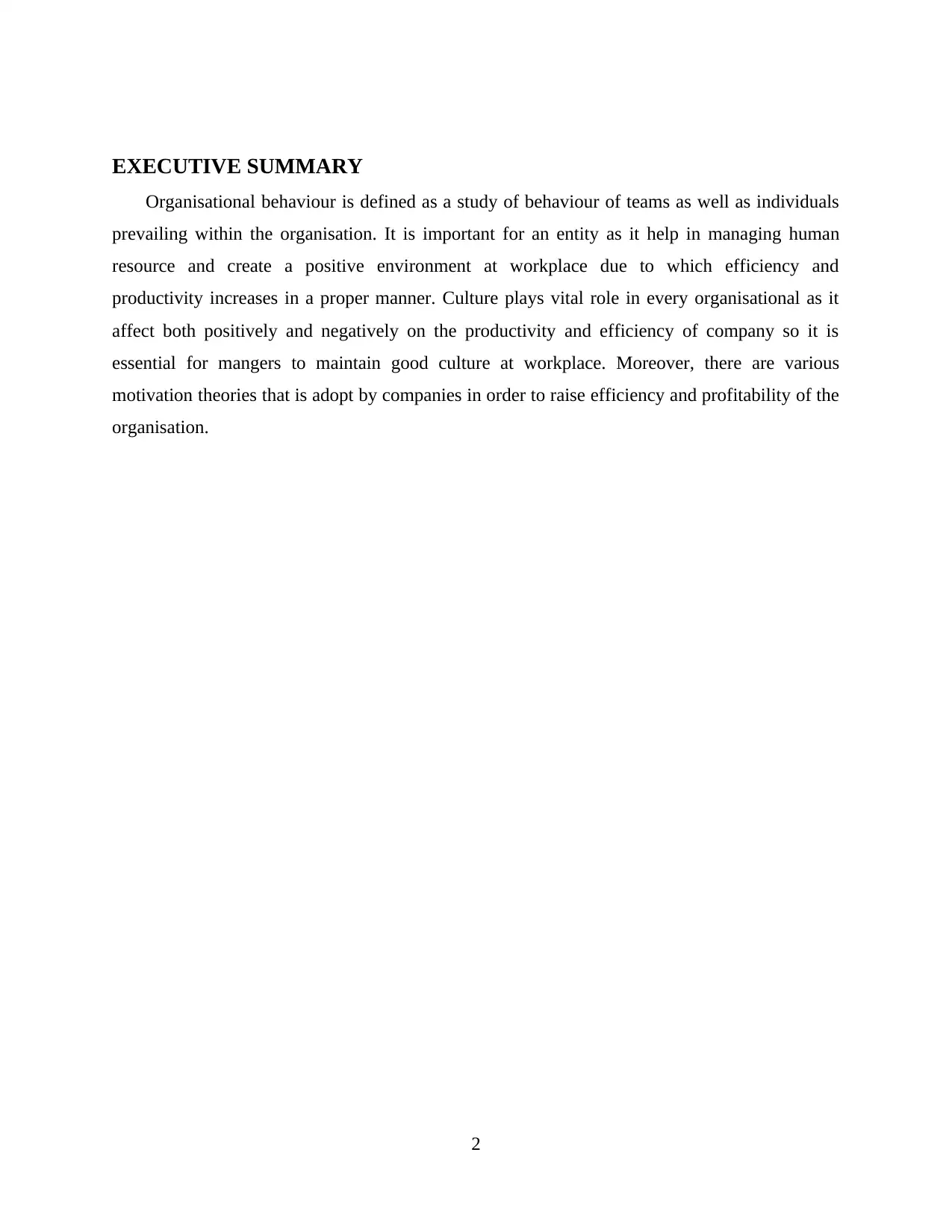
EXECUTIVE SUMMARY
Organisational behaviour is defined as a study of behaviour of teams as well as individuals
prevailing within the organisation. It is important for an entity as it help in managing human
resource and create a positive environment at workplace due to which efficiency and
productivity increases in a proper manner. Culture plays vital role in every organisational as it
affect both positively and negatively on the productivity and efficiency of company so it is
essential for mangers to maintain good culture at workplace. Moreover, there are various
motivation theories that is adopt by companies in order to raise efficiency and profitability of the
organisation.
2
Organisational behaviour is defined as a study of behaviour of teams as well as individuals
prevailing within the organisation. It is important for an entity as it help in managing human
resource and create a positive environment at workplace due to which efficiency and
productivity increases in a proper manner. Culture plays vital role in every organisational as it
affect both positively and negatively on the productivity and efficiency of company so it is
essential for mangers to maintain good culture at workplace. Moreover, there are various
motivation theories that is adopt by companies in order to raise efficiency and profitability of the
organisation.
2
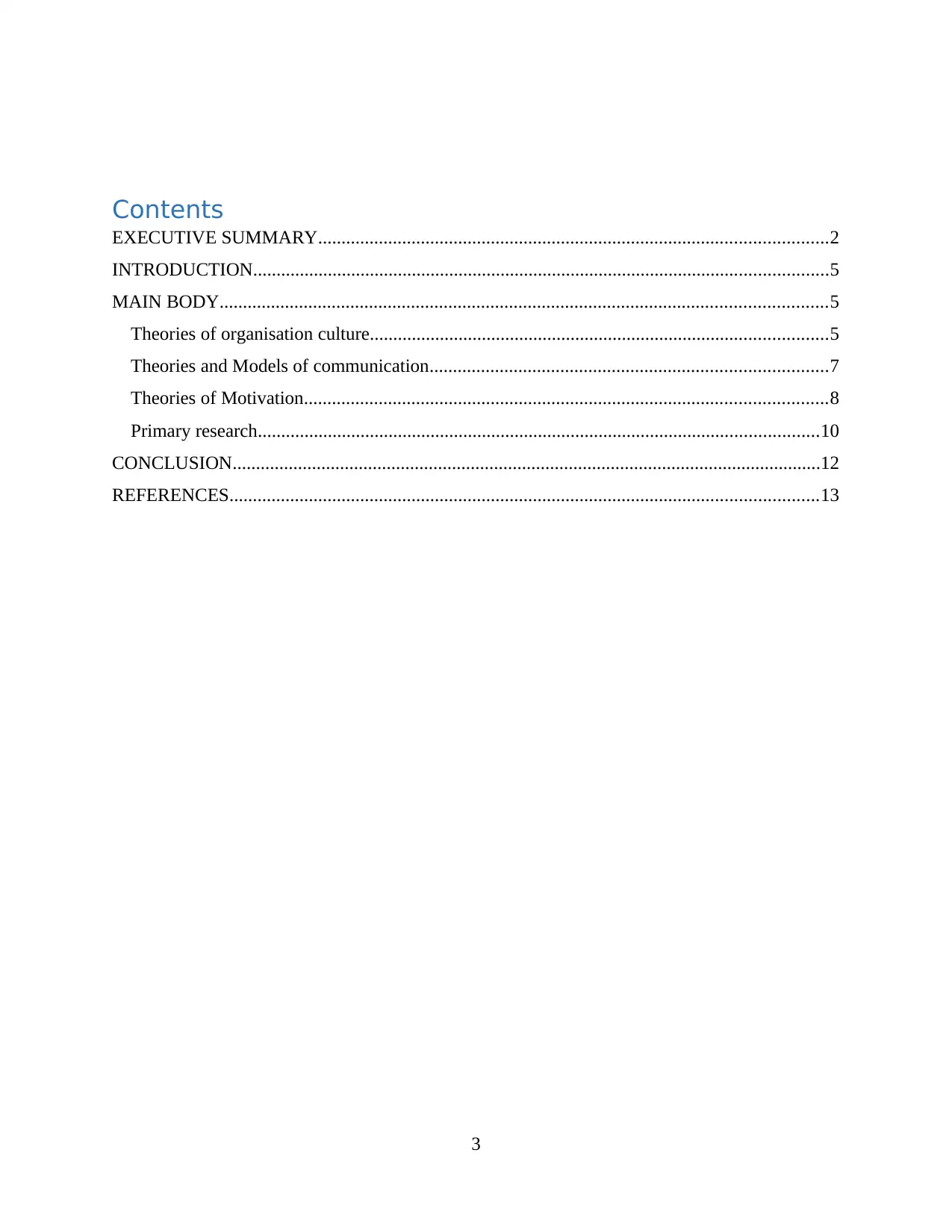
Contents
EXECUTIVE SUMMARY.............................................................................................................2
INTRODUCTION...........................................................................................................................5
MAIN BODY..................................................................................................................................5
Theories of organisation culture..................................................................................................5
Theories and Models of communication.....................................................................................7
Theories of Motivation................................................................................................................8
Primary research........................................................................................................................10
CONCLUSION..............................................................................................................................12
REFERENCES..............................................................................................................................13
3
EXECUTIVE SUMMARY.............................................................................................................2
INTRODUCTION...........................................................................................................................5
MAIN BODY..................................................................................................................................5
Theories of organisation culture..................................................................................................5
Theories and Models of communication.....................................................................................7
Theories of Motivation................................................................................................................8
Primary research........................................................................................................................10
CONCLUSION..............................................................................................................................12
REFERENCES..............................................................................................................................13
3

4
Secure Best Marks with AI Grader
Need help grading? Try our AI Grader for instant feedback on your assignments.
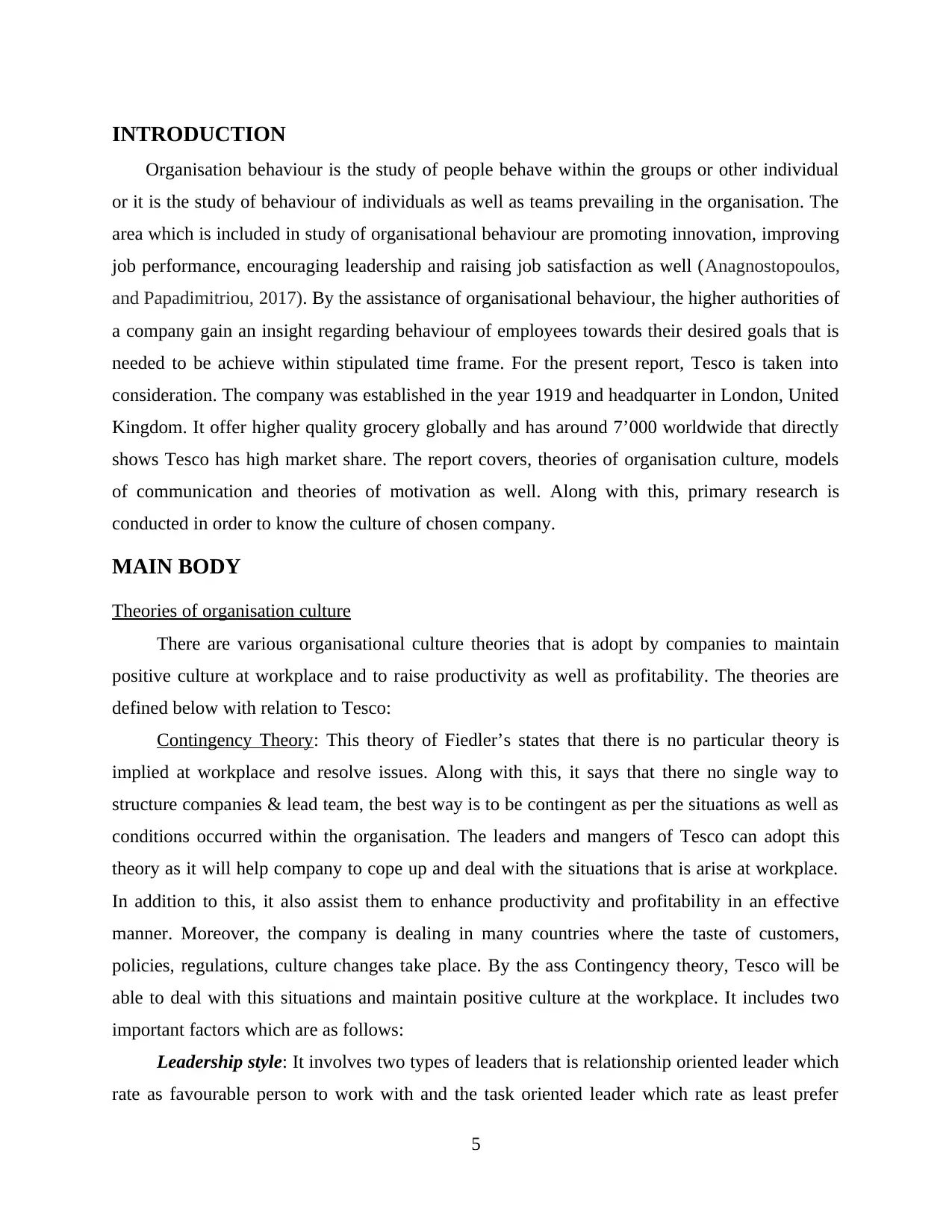
INTRODUCTION
Organisation behaviour is the study of people behave within the groups or other individual
or it is the study of behaviour of individuals as well as teams prevailing in the organisation. The
area which is included in study of organisational behaviour are promoting innovation, improving
job performance, encouraging leadership and raising job satisfaction as well (Anagnostopoulos,
and Papadimitriou, 2017). By the assistance of organisational behaviour, the higher authorities of
a company gain an insight regarding behaviour of employees towards their desired goals that is
needed to be achieve within stipulated time frame. For the present report, Tesco is taken into
consideration. The company was established in the year 1919 and headquarter in London, United
Kingdom. It offer higher quality grocery globally and has around 7’000 worldwide that directly
shows Tesco has high market share. The report covers, theories of organisation culture, models
of communication and theories of motivation as well. Along with this, primary research is
conducted in order to know the culture of chosen company.
MAIN BODY
Theories of organisation culture
There are various organisational culture theories that is adopt by companies to maintain
positive culture at workplace and to raise productivity as well as profitability. The theories are
defined below with relation to Tesco:
Contingency Theory: This theory of Fiedler’s states that there is no particular theory is
implied at workplace and resolve issues. Along with this, it says that there no single way to
structure companies & lead team, the best way is to be contingent as per the situations as well as
conditions occurred within the organisation. The leaders and mangers of Tesco can adopt this
theory as it will help company to cope up and deal with the situations that is arise at workplace.
In addition to this, it also assist them to enhance productivity and profitability in an effective
manner. Moreover, the company is dealing in many countries where the taste of customers,
policies, regulations, culture changes take place. By the ass Contingency theory, Tesco will be
able to deal with this situations and maintain positive culture at the workplace. It includes two
important factors which are as follows:
Leadership style: It involves two types of leaders that is relationship oriented leader which
rate as favourable person to work with and the task oriented leader which rate as least prefer
5
Organisation behaviour is the study of people behave within the groups or other individual
or it is the study of behaviour of individuals as well as teams prevailing in the organisation. The
area which is included in study of organisational behaviour are promoting innovation, improving
job performance, encouraging leadership and raising job satisfaction as well (Anagnostopoulos,
and Papadimitriou, 2017). By the assistance of organisational behaviour, the higher authorities of
a company gain an insight regarding behaviour of employees towards their desired goals that is
needed to be achieve within stipulated time frame. For the present report, Tesco is taken into
consideration. The company was established in the year 1919 and headquarter in London, United
Kingdom. It offer higher quality grocery globally and has around 7’000 worldwide that directly
shows Tesco has high market share. The report covers, theories of organisation culture, models
of communication and theories of motivation as well. Along with this, primary research is
conducted in order to know the culture of chosen company.
MAIN BODY
Theories of organisation culture
There are various organisational culture theories that is adopt by companies to maintain
positive culture at workplace and to raise productivity as well as profitability. The theories are
defined below with relation to Tesco:
Contingency Theory: This theory of Fiedler’s states that there is no particular theory is
implied at workplace and resolve issues. Along with this, it says that there no single way to
structure companies & lead team, the best way is to be contingent as per the situations as well as
conditions occurred within the organisation. The leaders and mangers of Tesco can adopt this
theory as it will help company to cope up and deal with the situations that is arise at workplace.
In addition to this, it also assist them to enhance productivity and profitability in an effective
manner. Moreover, the company is dealing in many countries where the taste of customers,
policies, regulations, culture changes take place. By the ass Contingency theory, Tesco will be
able to deal with this situations and maintain positive culture at the workplace. It includes two
important factors which are as follows:
Leadership style: It involves two types of leaders that is relationship oriented leader which
rate as favourable person to work with and the task oriented leader which rate as least prefer
5
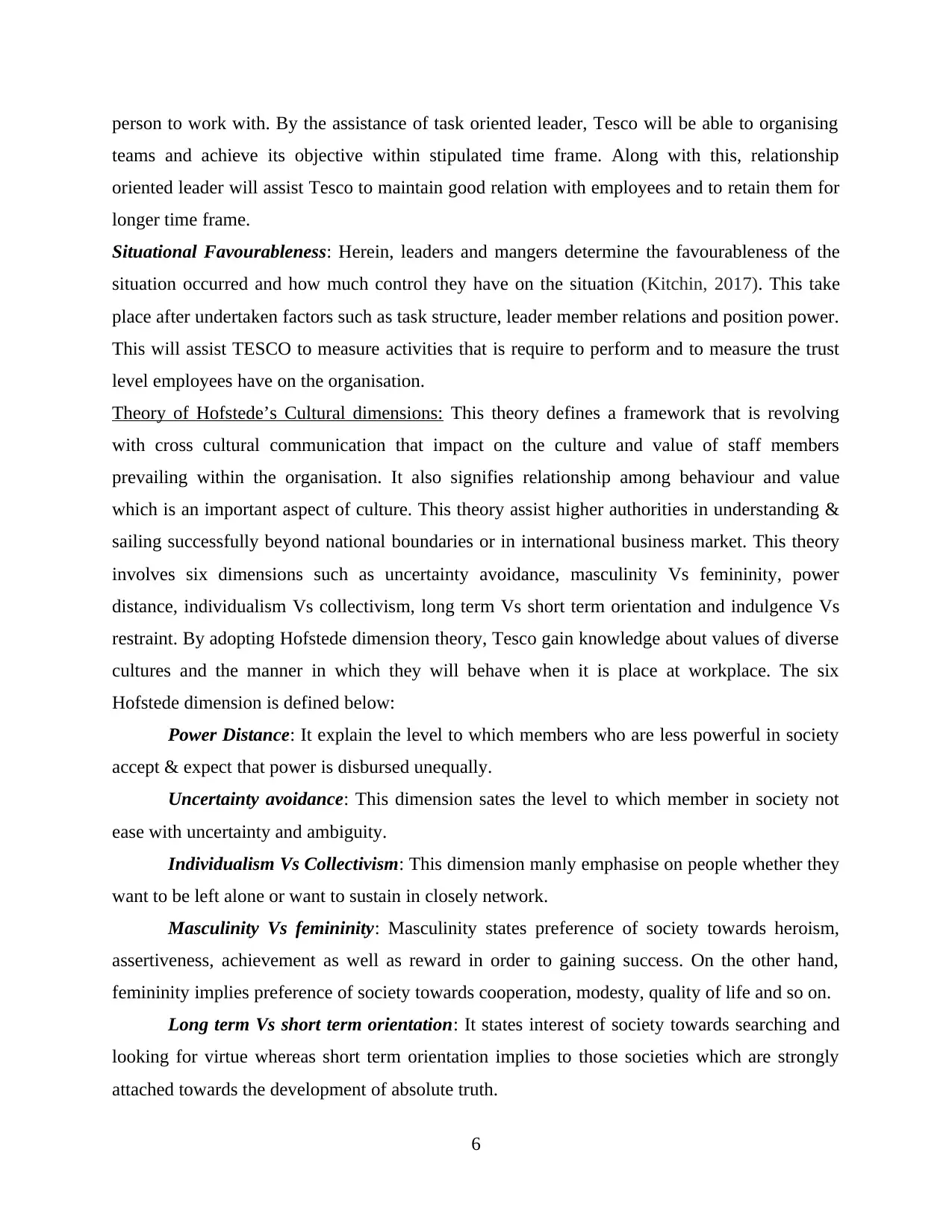
person to work with. By the assistance of task oriented leader, Tesco will be able to organising
teams and achieve its objective within stipulated time frame. Along with this, relationship
oriented leader will assist Tesco to maintain good relation with employees and to retain them for
longer time frame.
Situational Favourableness: Herein, leaders and mangers determine the favourableness of the
situation occurred and how much control they have on the situation (Kitchin, 2017). This take
place after undertaken factors such as task structure, leader member relations and position power.
This will assist TESCO to measure activities that is require to perform and to measure the trust
level employees have on the organisation.
Theory of Hofstede’s Cultural dimensions: This theory defines a framework that is revolving
with cross cultural communication that impact on the culture and value of staff members
prevailing within the organisation. It also signifies relationship among behaviour and value
which is an important aspect of culture. This theory assist higher authorities in understanding &
sailing successfully beyond national boundaries or in international business market. This theory
involves six dimensions such as uncertainty avoidance, masculinity Vs femininity, power
distance, individualism Vs collectivism, long term Vs short term orientation and indulgence Vs
restraint. By adopting Hofstede dimension theory, Tesco gain knowledge about values of diverse
cultures and the manner in which they will behave when it is place at workplace. The six
Hofstede dimension is defined below:
Power Distance: It explain the level to which members who are less powerful in society
accept & expect that power is disbursed unequally.
Uncertainty avoidance: This dimension sates the level to which member in society not
ease with uncertainty and ambiguity.
Individualism Vs Collectivism: This dimension manly emphasise on people whether they
want to be left alone or want to sustain in closely network.
Masculinity Vs femininity: Masculinity states preference of society towards heroism,
assertiveness, achievement as well as reward in order to gaining success. On the other hand,
femininity implies preference of society towards cooperation, modesty, quality of life and so on.
Long term Vs short term orientation: It states interest of society towards searching and
looking for virtue whereas short term orientation implies to those societies which are strongly
attached towards the development of absolute truth.
6
teams and achieve its objective within stipulated time frame. Along with this, relationship
oriented leader will assist Tesco to maintain good relation with employees and to retain them for
longer time frame.
Situational Favourableness: Herein, leaders and mangers determine the favourableness of the
situation occurred and how much control they have on the situation (Kitchin, 2017). This take
place after undertaken factors such as task structure, leader member relations and position power.
This will assist TESCO to measure activities that is require to perform and to measure the trust
level employees have on the organisation.
Theory of Hofstede’s Cultural dimensions: This theory defines a framework that is revolving
with cross cultural communication that impact on the culture and value of staff members
prevailing within the organisation. It also signifies relationship among behaviour and value
which is an important aspect of culture. This theory assist higher authorities in understanding &
sailing successfully beyond national boundaries or in international business market. This theory
involves six dimensions such as uncertainty avoidance, masculinity Vs femininity, power
distance, individualism Vs collectivism, long term Vs short term orientation and indulgence Vs
restraint. By adopting Hofstede dimension theory, Tesco gain knowledge about values of diverse
cultures and the manner in which they will behave when it is place at workplace. The six
Hofstede dimension is defined below:
Power Distance: It explain the level to which members who are less powerful in society
accept & expect that power is disbursed unequally.
Uncertainty avoidance: This dimension sates the level to which member in society not
ease with uncertainty and ambiguity.
Individualism Vs Collectivism: This dimension manly emphasise on people whether they
want to be left alone or want to sustain in closely network.
Masculinity Vs femininity: Masculinity states preference of society towards heroism,
assertiveness, achievement as well as reward in order to gaining success. On the other hand,
femininity implies preference of society towards cooperation, modesty, quality of life and so on.
Long term Vs short term orientation: It states interest of society towards searching and
looking for virtue whereas short term orientation implies to those societies which are strongly
attached towards the development of absolute truth.
6
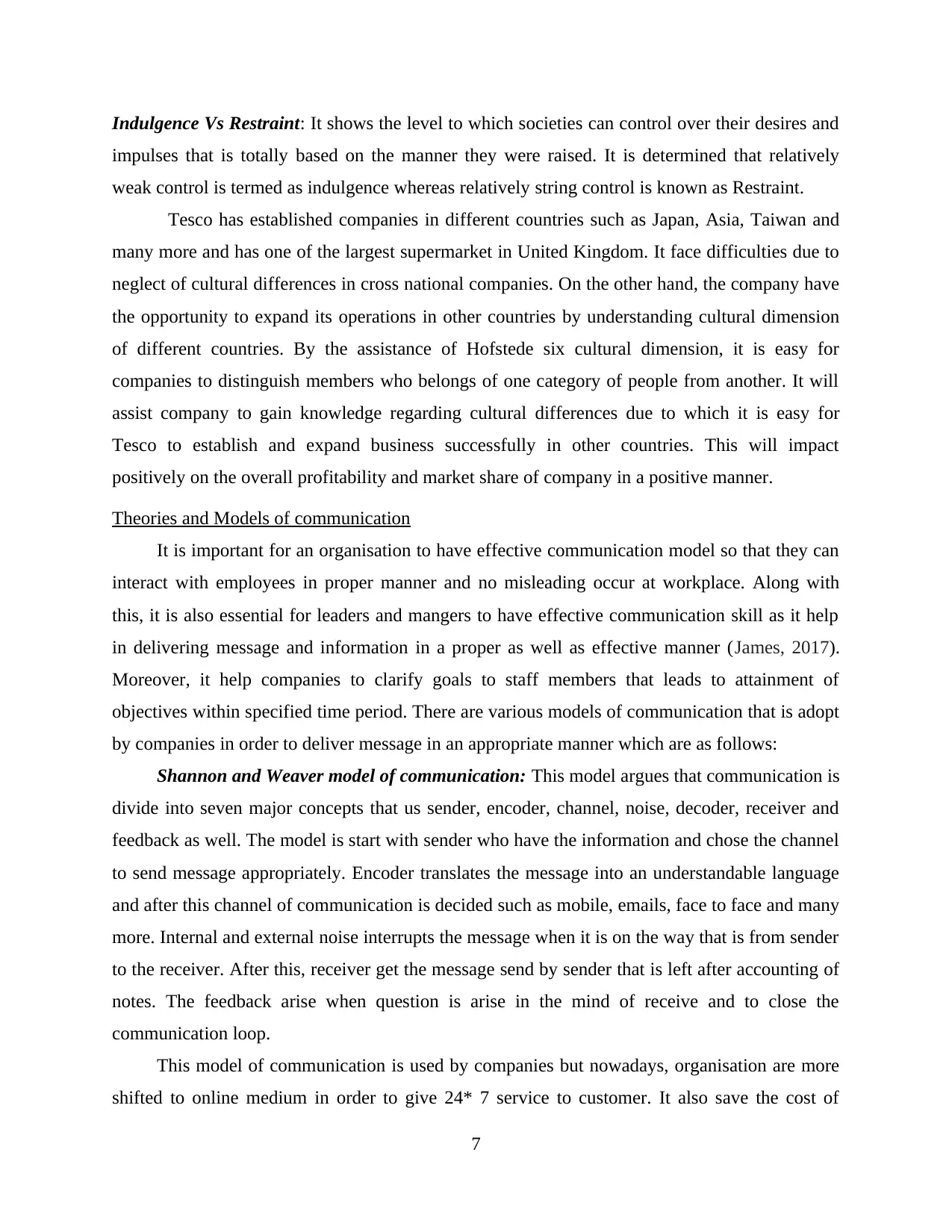
Indulgence Vs Restraint: It shows the level to which societies can control over their desires and
impulses that is totally based on the manner they were raised. It is determined that relatively
weak control is termed as indulgence whereas relatively string control is known as Restraint.
Tesco has established companies in different countries such as Japan, Asia, Taiwan and
many more and has one of the largest supermarket in United Kingdom. It face difficulties due to
neglect of cultural differences in cross national companies. On the other hand, the company have
the opportunity to expand its operations in other countries by understanding cultural dimension
of different countries. By the assistance of Hofstede six cultural dimension, it is easy for
companies to distinguish members who belongs of one category of people from another. It will
assist company to gain knowledge regarding cultural differences due to which it is easy for
Tesco to establish and expand business successfully in other countries. This will impact
positively on the overall profitability and market share of company in a positive manner.
Theories and Models of communication
It is important for an organisation to have effective communication model so that they can
interact with employees in proper manner and no misleading occur at workplace. Along with
this, it is also essential for leaders and mangers to have effective communication skill as it help
in delivering message and information in a proper as well as effective manner (James, 2017).
Moreover, it help companies to clarify goals to staff members that leads to attainment of
objectives within specified time period. There are various models of communication that is adopt
by companies in order to deliver message in an appropriate manner which are as follows:
Shannon and Weaver model of communication: This model argues that communication is
divide into seven major concepts that us sender, encoder, channel, noise, decoder, receiver and
feedback as well. The model is start with sender who have the information and chose the channel
to send message appropriately. Encoder translates the message into an understandable language
and after this channel of communication is decided such as mobile, emails, face to face and many
more. Internal and external noise interrupts the message when it is on the way that is from sender
to the receiver. After this, receiver get the message send by sender that is left after accounting of
notes. The feedback arise when question is arise in the mind of receive and to close the
communication loop.
This model of communication is used by companies but nowadays, organisation are more
shifted to online medium in order to give 24* 7 service to customer. It also save the cost of
7
impulses that is totally based on the manner they were raised. It is determined that relatively
weak control is termed as indulgence whereas relatively string control is known as Restraint.
Tesco has established companies in different countries such as Japan, Asia, Taiwan and
many more and has one of the largest supermarket in United Kingdom. It face difficulties due to
neglect of cultural differences in cross national companies. On the other hand, the company have
the opportunity to expand its operations in other countries by understanding cultural dimension
of different countries. By the assistance of Hofstede six cultural dimension, it is easy for
companies to distinguish members who belongs of one category of people from another. It will
assist company to gain knowledge regarding cultural differences due to which it is easy for
Tesco to establish and expand business successfully in other countries. This will impact
positively on the overall profitability and market share of company in a positive manner.
Theories and Models of communication
It is important for an organisation to have effective communication model so that they can
interact with employees in proper manner and no misleading occur at workplace. Along with
this, it is also essential for leaders and mangers to have effective communication skill as it help
in delivering message and information in a proper as well as effective manner (James, 2017).
Moreover, it help companies to clarify goals to staff members that leads to attainment of
objectives within specified time period. There are various models of communication that is adopt
by companies in order to deliver message in an appropriate manner which are as follows:
Shannon and Weaver model of communication: This model argues that communication is
divide into seven major concepts that us sender, encoder, channel, noise, decoder, receiver and
feedback as well. The model is start with sender who have the information and chose the channel
to send message appropriately. Encoder translates the message into an understandable language
and after this channel of communication is decided such as mobile, emails, face to face and many
more. Internal and external noise interrupts the message when it is on the way that is from sender
to the receiver. After this, receiver get the message send by sender that is left after accounting of
notes. The feedback arise when question is arise in the mind of receive and to close the
communication loop.
This model of communication is used by companies but nowadays, organisation are more
shifted to online medium in order to give 24* 7 service to customer. It also save the cost of
7
Paraphrase This Document
Need a fresh take? Get an instant paraphrase of this document with our AI Paraphraser
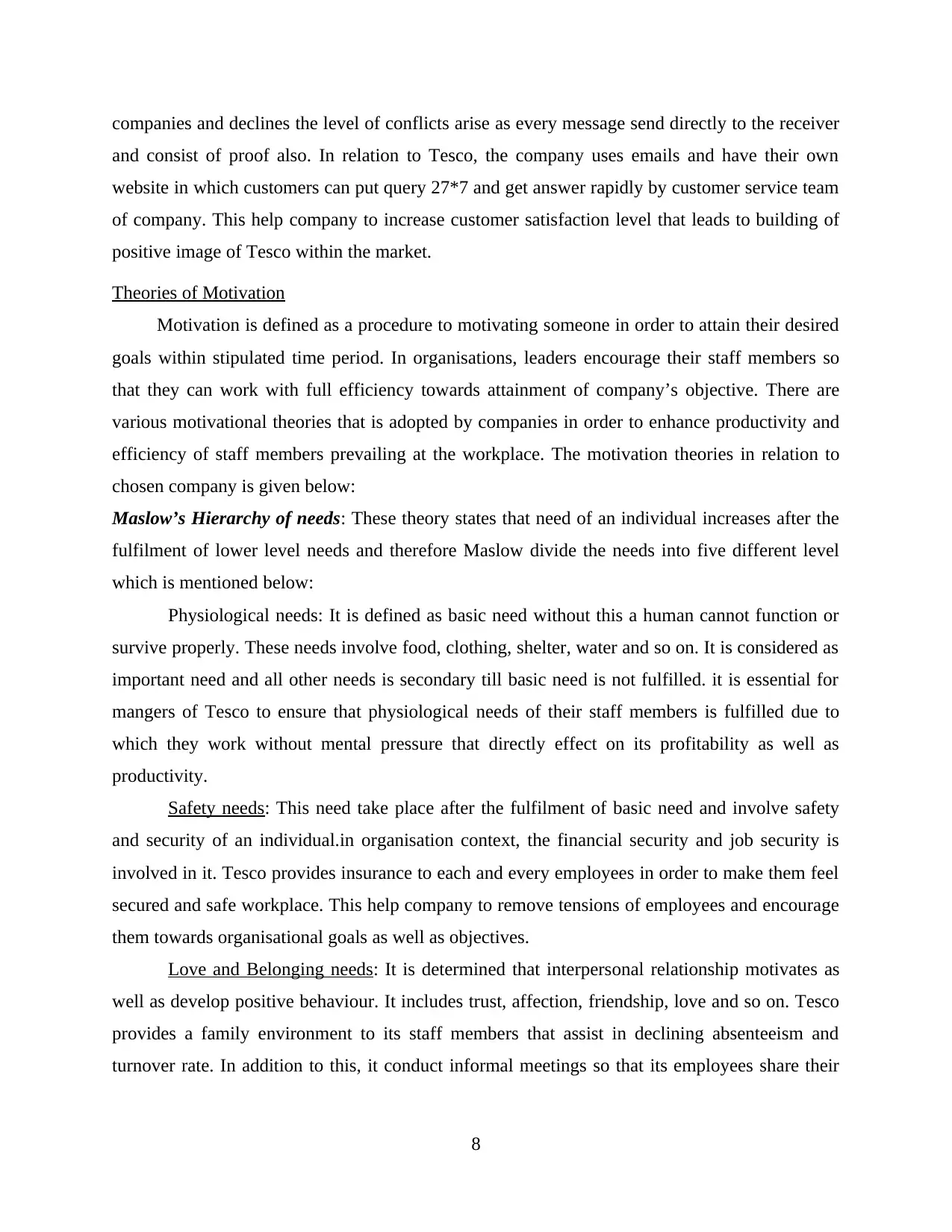
companies and declines the level of conflicts arise as every message send directly to the receiver
and consist of proof also. In relation to Tesco, the company uses emails and have their own
website in which customers can put query 27*7 and get answer rapidly by customer service team
of company. This help company to increase customer satisfaction level that leads to building of
positive image of Tesco within the market.
Theories of Motivation
Motivation is defined as a procedure to motivating someone in order to attain their desired
goals within stipulated time period. In organisations, leaders encourage their staff members so
that they can work with full efficiency towards attainment of company’s objective. There are
various motivational theories that is adopted by companies in order to enhance productivity and
efficiency of staff members prevailing at the workplace. The motivation theories in relation to
chosen company is given below:
Maslow’s Hierarchy of needs: These theory states that need of an individual increases after the
fulfilment of lower level needs and therefore Maslow divide the needs into five different level
which is mentioned below:
Physiological needs: It is defined as basic need without this a human cannot function or
survive properly. These needs involve food, clothing, shelter, water and so on. It is considered as
important need and all other needs is secondary till basic need is not fulfilled. it is essential for
mangers of Tesco to ensure that physiological needs of their staff members is fulfilled due to
which they work without mental pressure that directly effect on its profitability as well as
productivity.
Safety needs: This need take place after the fulfilment of basic need and involve safety
and security of an individual.in organisation context, the financial security and job security is
involved in it. Tesco provides insurance to each and every employees in order to make them feel
secured and safe workplace. This help company to remove tensions of employees and encourage
them towards organisational goals as well as objectives.
Love and Belonging needs: It is determined that interpersonal relationship motivates as
well as develop positive behaviour. It includes trust, affection, friendship, love and so on. Tesco
provides a family environment to its staff members that assist in declining absenteeism and
turnover rate. In addition to this, it conduct informal meetings so that its employees share their
8
and consist of proof also. In relation to Tesco, the company uses emails and have their own
website in which customers can put query 27*7 and get answer rapidly by customer service team
of company. This help company to increase customer satisfaction level that leads to building of
positive image of Tesco within the market.
Theories of Motivation
Motivation is defined as a procedure to motivating someone in order to attain their desired
goals within stipulated time period. In organisations, leaders encourage their staff members so
that they can work with full efficiency towards attainment of company’s objective. There are
various motivational theories that is adopted by companies in order to enhance productivity and
efficiency of staff members prevailing at the workplace. The motivation theories in relation to
chosen company is given below:
Maslow’s Hierarchy of needs: These theory states that need of an individual increases after the
fulfilment of lower level needs and therefore Maslow divide the needs into five different level
which is mentioned below:
Physiological needs: It is defined as basic need without this a human cannot function or
survive properly. These needs involve food, clothing, shelter, water and so on. It is considered as
important need and all other needs is secondary till basic need is not fulfilled. it is essential for
mangers of Tesco to ensure that physiological needs of their staff members is fulfilled due to
which they work without mental pressure that directly effect on its profitability as well as
productivity.
Safety needs: This need take place after the fulfilment of basic need and involve safety
and security of an individual.in organisation context, the financial security and job security is
involved in it. Tesco provides insurance to each and every employees in order to make them feel
secured and safe workplace. This help company to remove tensions of employees and encourage
them towards organisational goals as well as objectives.
Love and Belonging needs: It is determined that interpersonal relationship motivates as
well as develop positive behaviour. It includes trust, affection, friendship, love and so on. Tesco
provides a family environment to its staff members that assist in declining absenteeism and
turnover rate. In addition to this, it conduct informal meetings so that its employees share their
8
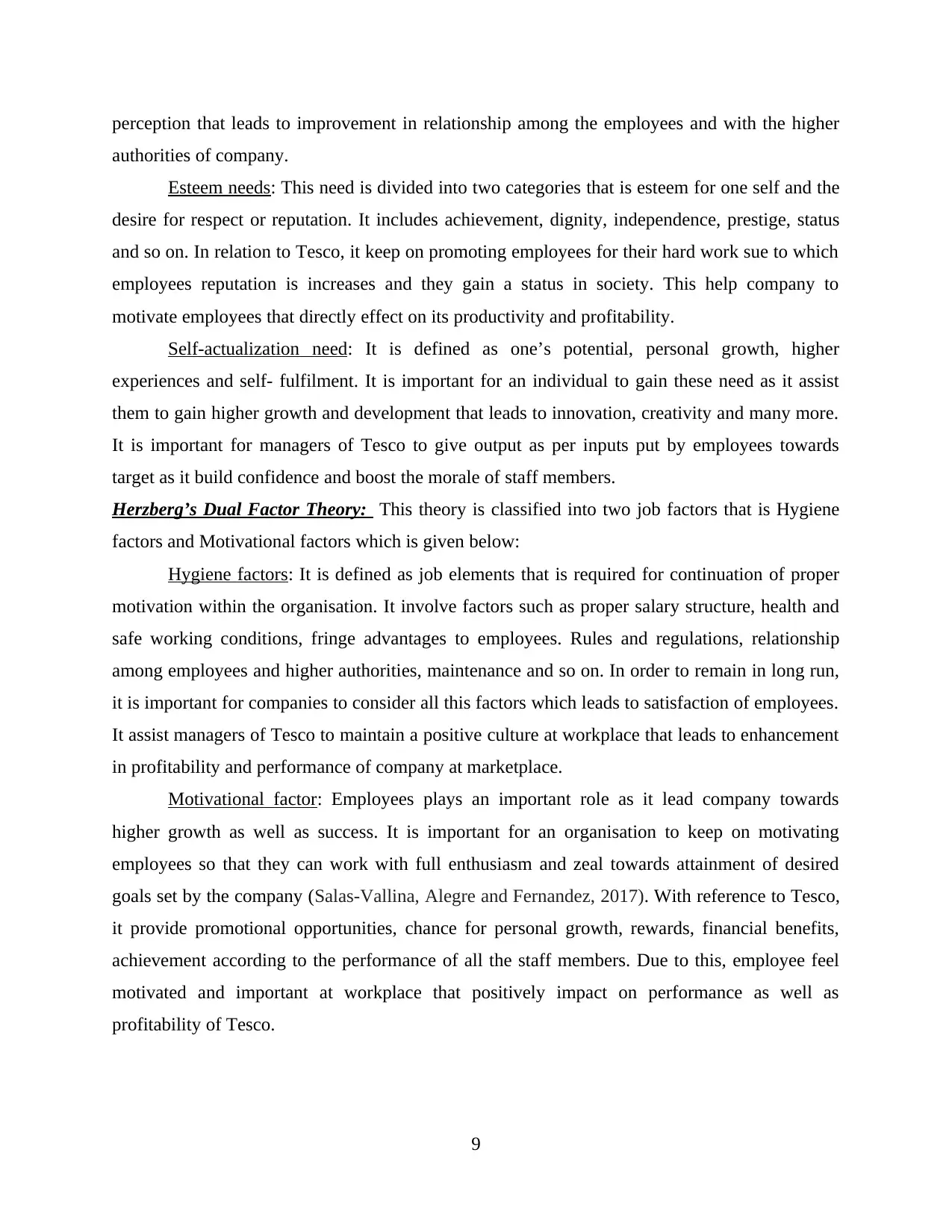
perception that leads to improvement in relationship among the employees and with the higher
authorities of company.
Esteem needs: This need is divided into two categories that is esteem for one self and the
desire for respect or reputation. It includes achievement, dignity, independence, prestige, status
and so on. In relation to Tesco, it keep on promoting employees for their hard work sue to which
employees reputation is increases and they gain a status in society. This help company to
motivate employees that directly effect on its productivity and profitability.
Self-actualization need: It is defined as one’s potential, personal growth, higher
experiences and self- fulfilment. It is important for an individual to gain these need as it assist
them to gain higher growth and development that leads to innovation, creativity and many more.
It is important for managers of Tesco to give output as per inputs put by employees towards
target as it build confidence and boost the morale of staff members.
Herzberg’s Dual Factor Theory: This theory is classified into two job factors that is Hygiene
factors and Motivational factors which is given below:
Hygiene factors: It is defined as job elements that is required for continuation of proper
motivation within the organisation. It involve factors such as proper salary structure, health and
safe working conditions, fringe advantages to employees. Rules and regulations, relationship
among employees and higher authorities, maintenance and so on. In order to remain in long run,
it is important for companies to consider all this factors which leads to satisfaction of employees.
It assist managers of Tesco to maintain a positive culture at workplace that leads to enhancement
in profitability and performance of company at marketplace.
Motivational factor: Employees plays an important role as it lead company towards
higher growth as well as success. It is important for an organisation to keep on motivating
employees so that they can work with full enthusiasm and zeal towards attainment of desired
goals set by the company (Salas-Vallina, Alegre and Fernandez, 2017). With reference to Tesco,
it provide promotional opportunities, chance for personal growth, rewards, financial benefits,
achievement according to the performance of all the staff members. Due to this, employee feel
motivated and important at workplace that positively impact on performance as well as
profitability of Tesco.
9
authorities of company.
Esteem needs: This need is divided into two categories that is esteem for one self and the
desire for respect or reputation. It includes achievement, dignity, independence, prestige, status
and so on. In relation to Tesco, it keep on promoting employees for their hard work sue to which
employees reputation is increases and they gain a status in society. This help company to
motivate employees that directly effect on its productivity and profitability.
Self-actualization need: It is defined as one’s potential, personal growth, higher
experiences and self- fulfilment. It is important for an individual to gain these need as it assist
them to gain higher growth and development that leads to innovation, creativity and many more.
It is important for managers of Tesco to give output as per inputs put by employees towards
target as it build confidence and boost the morale of staff members.
Herzberg’s Dual Factor Theory: This theory is classified into two job factors that is Hygiene
factors and Motivational factors which is given below:
Hygiene factors: It is defined as job elements that is required for continuation of proper
motivation within the organisation. It involve factors such as proper salary structure, health and
safe working conditions, fringe advantages to employees. Rules and regulations, relationship
among employees and higher authorities, maintenance and so on. In order to remain in long run,
it is important for companies to consider all this factors which leads to satisfaction of employees.
It assist managers of Tesco to maintain a positive culture at workplace that leads to enhancement
in profitability and performance of company at marketplace.
Motivational factor: Employees plays an important role as it lead company towards
higher growth as well as success. It is important for an organisation to keep on motivating
employees so that they can work with full enthusiasm and zeal towards attainment of desired
goals set by the company (Salas-Vallina, Alegre and Fernandez, 2017). With reference to Tesco,
it provide promotional opportunities, chance for personal growth, rewards, financial benefits,
achievement according to the performance of all the staff members. Due to this, employee feel
motivated and important at workplace that positively impact on performance as well as
profitability of Tesco.
9
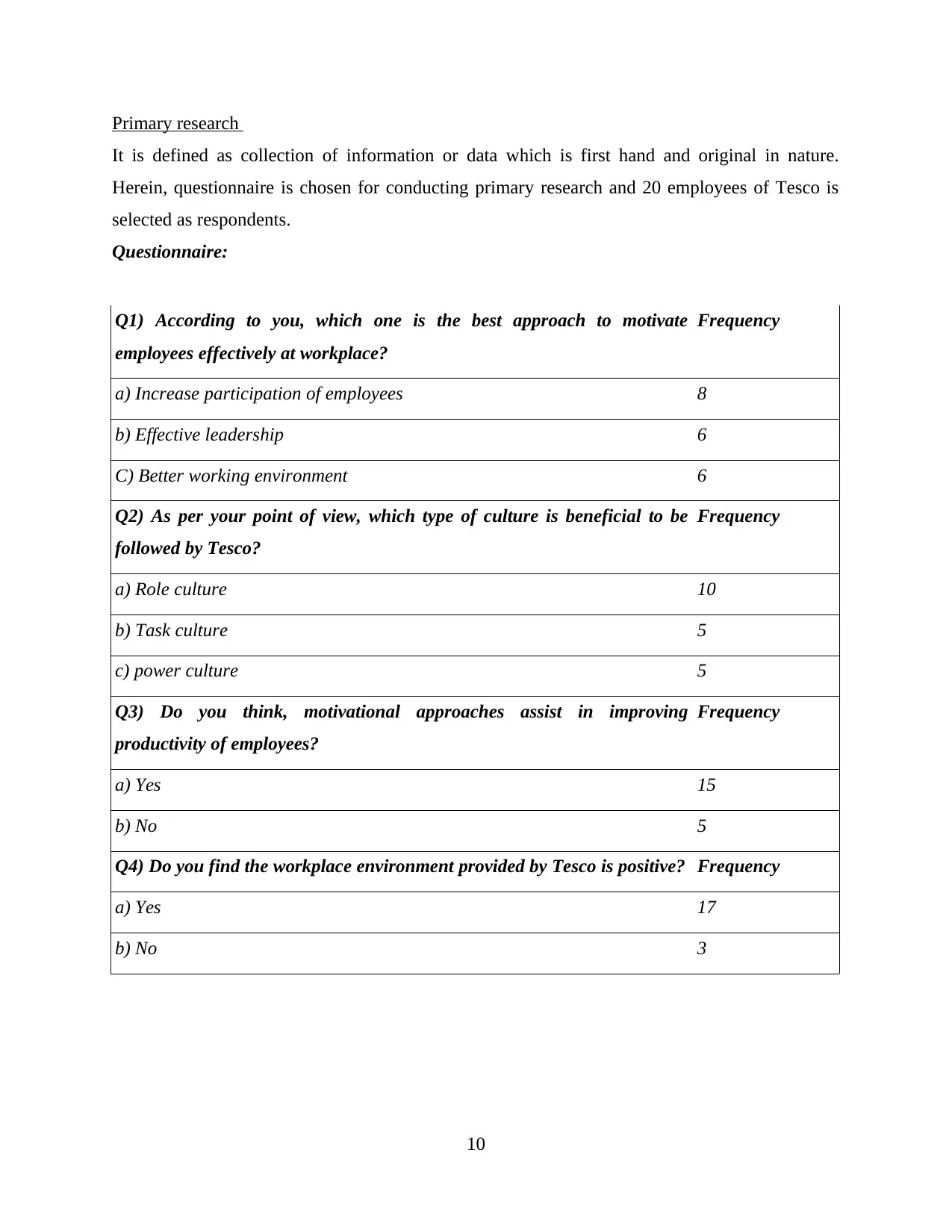
Primary research
It is defined as collection of information or data which is first hand and original in nature.
Herein, questionnaire is chosen for conducting primary research and 20 employees of Tesco is
selected as respondents.
Questionnaire:
Q1) According to you, which one is the best approach to motivate
employees effectively at workplace?
Frequency
a) Increase participation of employees 8
b) Effective leadership 6
C) Better working environment 6
Q2) As per your point of view, which type of culture is beneficial to be
followed by Tesco?
Frequency
a) Role culture 10
b) Task culture 5
c) power culture 5
Q3) Do you think, motivational approaches assist in improving
productivity of employees?
Frequency
a) Yes 15
b) No 5
Q4) Do you find the workplace environment provided by Tesco is positive? Frequency
a) Yes 17
b) No 3
10
It is defined as collection of information or data which is first hand and original in nature.
Herein, questionnaire is chosen for conducting primary research and 20 employees of Tesco is
selected as respondents.
Questionnaire:
Q1) According to you, which one is the best approach to motivate
employees effectively at workplace?
Frequency
a) Increase participation of employees 8
b) Effective leadership 6
C) Better working environment 6
Q2) As per your point of view, which type of culture is beneficial to be
followed by Tesco?
Frequency
a) Role culture 10
b) Task culture 5
c) power culture 5
Q3) Do you think, motivational approaches assist in improving
productivity of employees?
Frequency
a) Yes 15
b) No 5
Q4) Do you find the workplace environment provided by Tesco is positive? Frequency
a) Yes 17
b) No 3
10
Secure Best Marks with AI Grader
Need help grading? Try our AI Grader for instant feedback on your assignments.
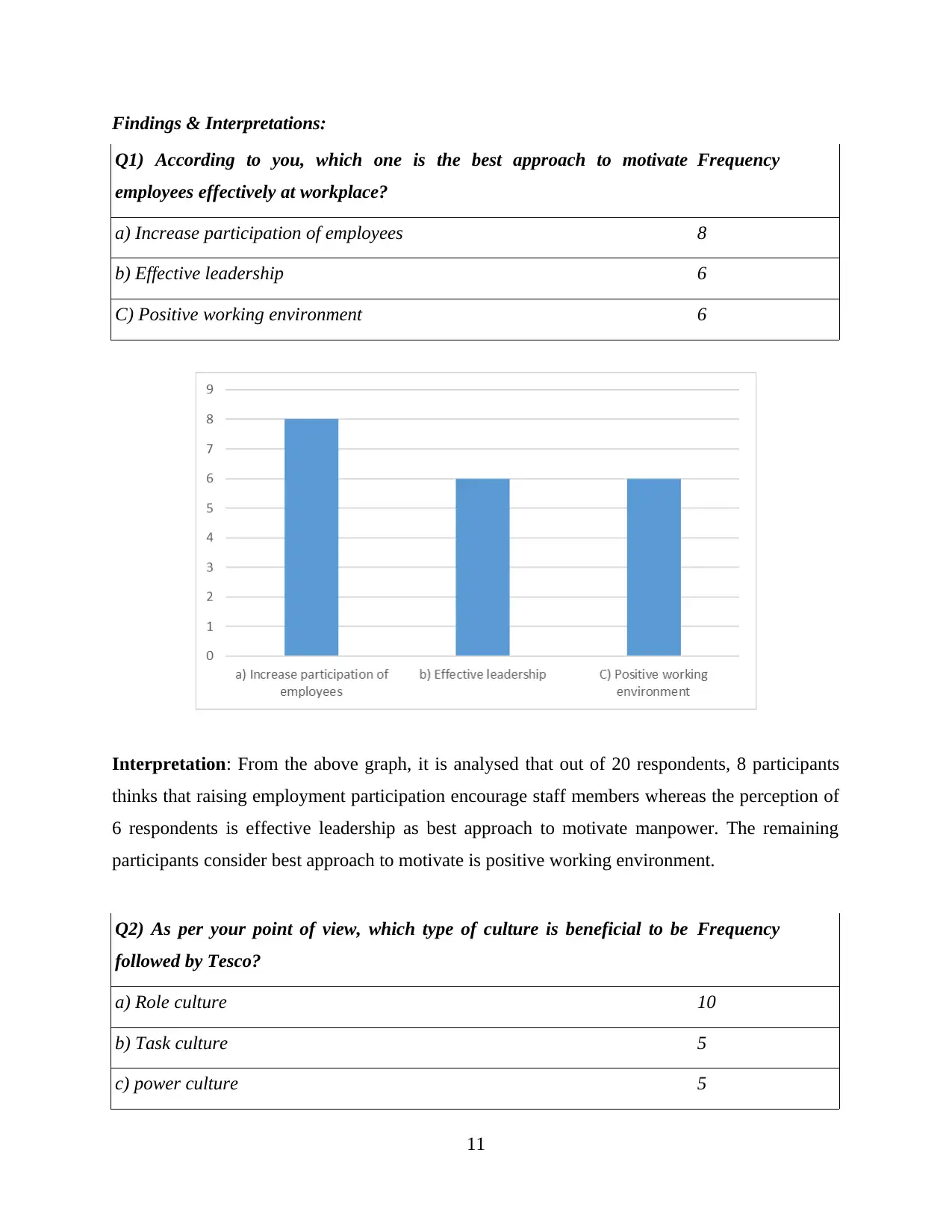
Findings & Interpretations:
Q1) According to you, which one is the best approach to motivate
employees effectively at workplace?
Frequency
a) Increase participation of employees 8
b) Effective leadership 6
C) Positive working environment 6
Interpretation: From the above graph, it is analysed that out of 20 respondents, 8 participants
thinks that raising employment participation encourage staff members whereas the perception of
6 respondents is effective leadership as best approach to motivate manpower. The remaining
participants consider best approach to motivate is positive working environment.
Q2) As per your point of view, which type of culture is beneficial to be
followed by Tesco?
Frequency
a) Role culture 10
b) Task culture 5
c) power culture 5
11
Q1) According to you, which one is the best approach to motivate
employees effectively at workplace?
Frequency
a) Increase participation of employees 8
b) Effective leadership 6
C) Positive working environment 6
Interpretation: From the above graph, it is analysed that out of 20 respondents, 8 participants
thinks that raising employment participation encourage staff members whereas the perception of
6 respondents is effective leadership as best approach to motivate manpower. The remaining
participants consider best approach to motivate is positive working environment.
Q2) As per your point of view, which type of culture is beneficial to be
followed by Tesco?
Frequency
a) Role culture 10
b) Task culture 5
c) power culture 5
11
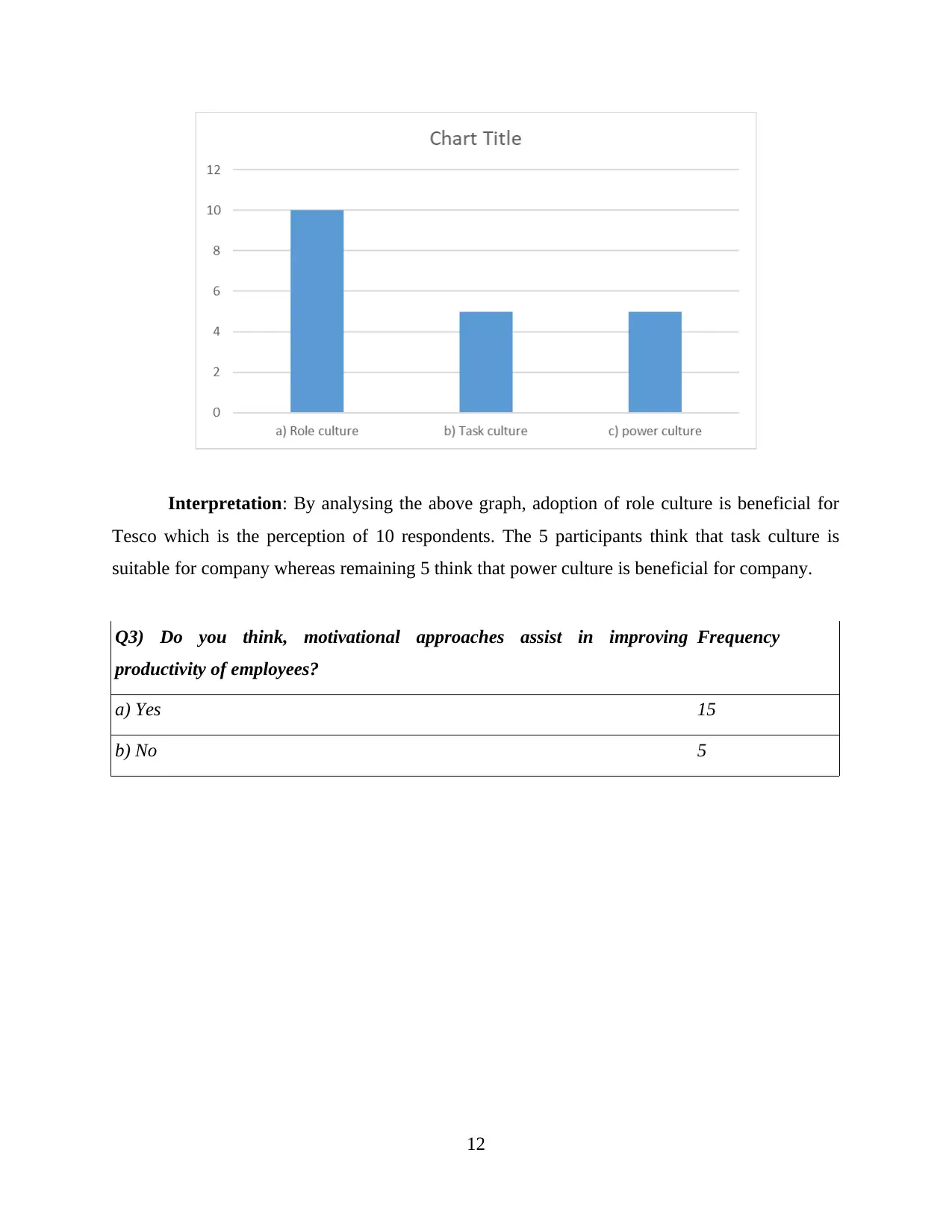
Interpretation: By analysing the above graph, adoption of role culture is beneficial for
Tesco which is the perception of 10 respondents. The 5 participants think that task culture is
suitable for company whereas remaining 5 think that power culture is beneficial for company.
Q3) Do you think, motivational approaches assist in improving
productivity of employees?
Frequency
a) Yes 15
b) No 5
12
Tesco which is the perception of 10 respondents. The 5 participants think that task culture is
suitable for company whereas remaining 5 think that power culture is beneficial for company.
Q3) Do you think, motivational approaches assist in improving
productivity of employees?
Frequency
a) Yes 15
b) No 5
12
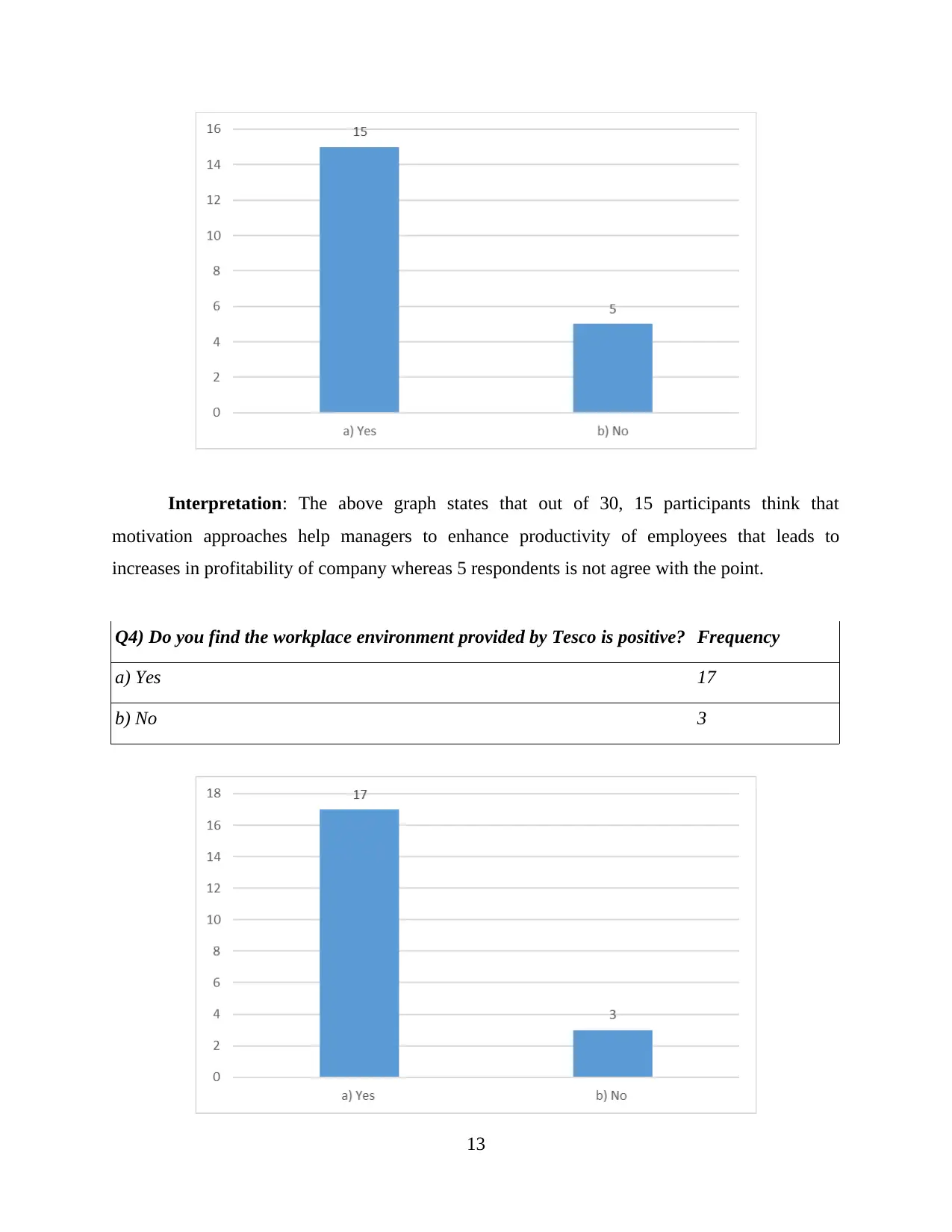
Interpretation: The above graph states that out of 30, 15 participants think that
motivation approaches help managers to enhance productivity of employees that leads to
increases in profitability of company whereas 5 respondents is not agree with the point.
Q4) Do you find the workplace environment provided by Tesco is positive? Frequency
a) Yes 17
b) No 3
13
motivation approaches help managers to enhance productivity of employees that leads to
increases in profitability of company whereas 5 respondents is not agree with the point.
Q4) Do you find the workplace environment provided by Tesco is positive? Frequency
a) Yes 17
b) No 3
13
Paraphrase This Document
Need a fresh take? Get an instant paraphrase of this document with our AI Paraphraser
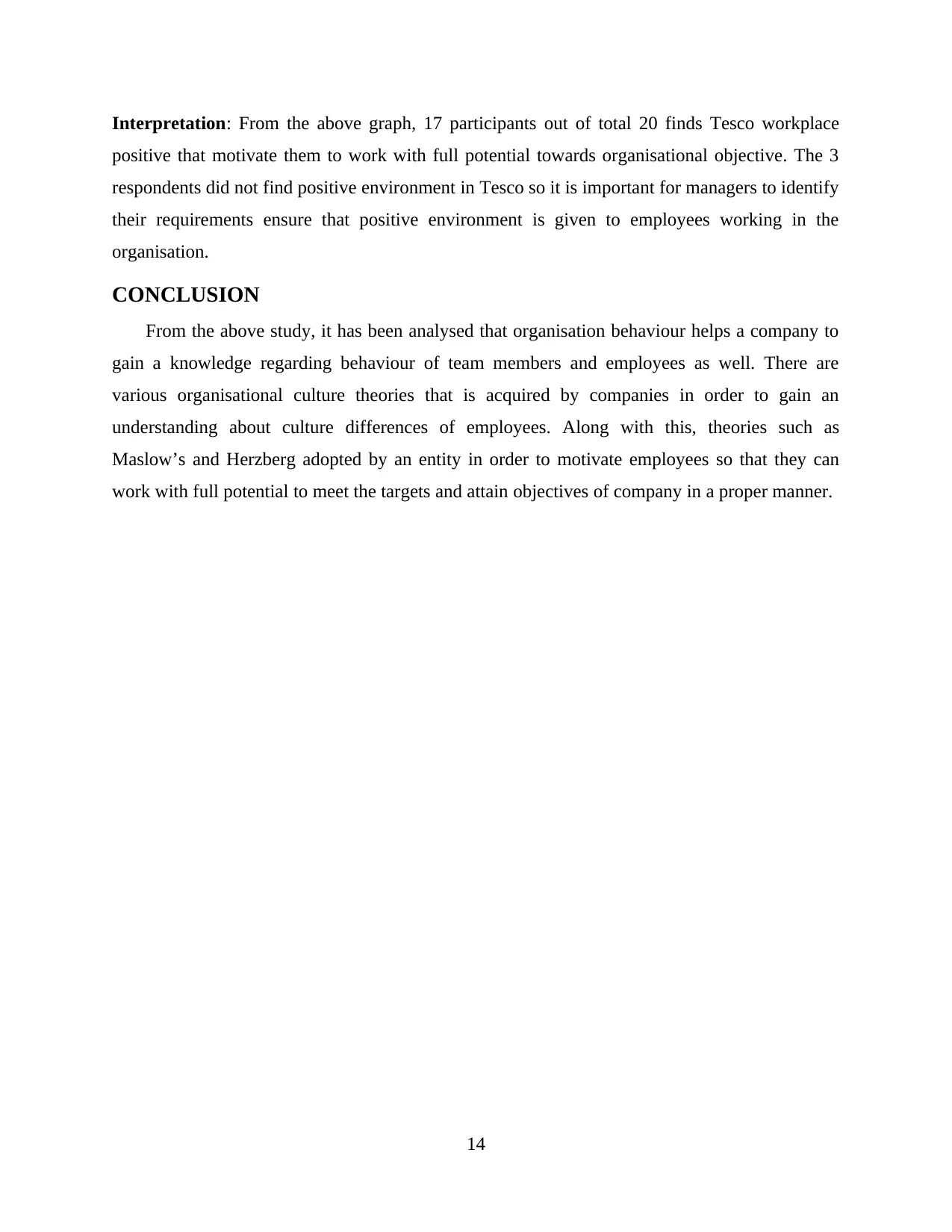
Interpretation: From the above graph, 17 participants out of total 20 finds Tesco workplace
positive that motivate them to work with full potential towards organisational objective. The 3
respondents did not find positive environment in Tesco so it is important for managers to identify
their requirements ensure that positive environment is given to employees working in the
organisation.
CONCLUSION
From the above study, it has been analysed that organisation behaviour helps a company to
gain a knowledge regarding behaviour of team members and employees as well. There are
various organisational culture theories that is acquired by companies in order to gain an
understanding about culture differences of employees. Along with this, theories such as
Maslow’s and Herzberg adopted by an entity in order to motivate employees so that they can
work with full potential to meet the targets and attain objectives of company in a proper manner.
14
positive that motivate them to work with full potential towards organisational objective. The 3
respondents did not find positive environment in Tesco so it is important for managers to identify
their requirements ensure that positive environment is given to employees working in the
organisation.
CONCLUSION
From the above study, it has been analysed that organisation behaviour helps a company to
gain a knowledge regarding behaviour of team members and employees as well. There are
various organisational culture theories that is acquired by companies in order to gain an
understanding about culture differences of employees. Along with this, theories such as
Maslow’s and Herzberg adopted by an entity in order to motivate employees so that they can
work with full potential to meet the targets and attain objectives of company in a proper manner.
14
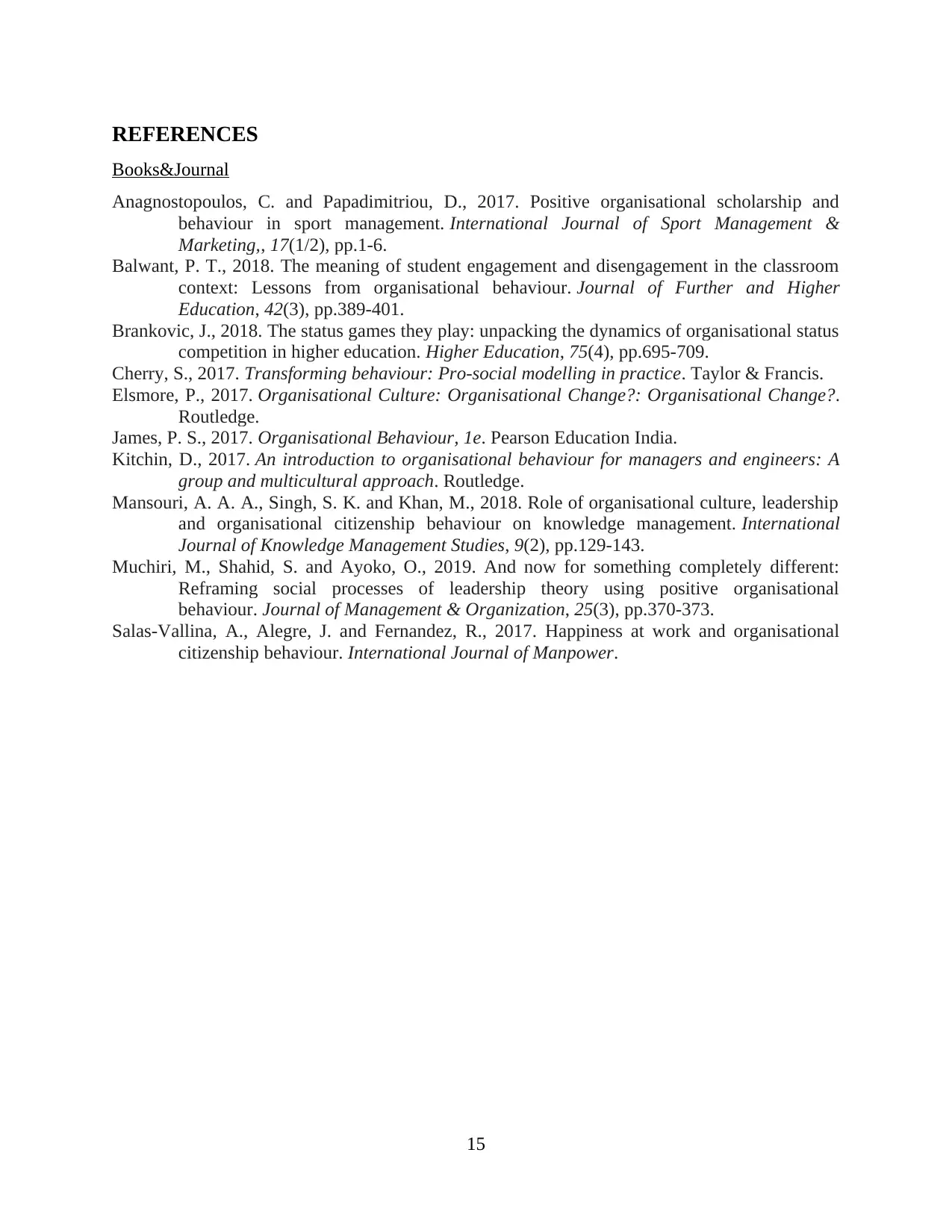
REFERENCES
Books&Journal
Anagnostopoulos, C. and Papadimitriou, D., 2017. Positive organisational scholarship and
behaviour in sport management. International Journal of Sport Management &
Marketing,, 17(1/2), pp.1-6.
Balwant, P. T., 2018. The meaning of student engagement and disengagement in the classroom
context: Lessons from organisational behaviour. Journal of Further and Higher
Education, 42(3), pp.389-401.
Brankovic, J., 2018. The status games they play: unpacking the dynamics of organisational status
competition in higher education. Higher Education, 75(4), pp.695-709.
Cherry, S., 2017. Transforming behaviour: Pro-social modelling in practice. Taylor & Francis.
Elsmore, P., 2017. Organisational Culture: Organisational Change?: Organisational Change?.
Routledge.
James, P. S., 2017. Organisational Behaviour, 1e. Pearson Education India.
Kitchin, D., 2017. An introduction to organisational behaviour for managers and engineers: A
group and multicultural approach. Routledge.
Mansouri, A. A. A., Singh, S. K. and Khan, M., 2018. Role of organisational culture, leadership
and organisational citizenship behaviour on knowledge management. International
Journal of Knowledge Management Studies, 9(2), pp.129-143.
Muchiri, M., Shahid, S. and Ayoko, O., 2019. And now for something completely different:
Reframing social processes of leadership theory using positive organisational
behaviour. Journal of Management & Organization, 25(3), pp.370-373.
Salas-Vallina, A., Alegre, J. and Fernandez, R., 2017. Happiness at work and organisational
citizenship behaviour. International Journal of Manpower.
15
Books&Journal
Anagnostopoulos, C. and Papadimitriou, D., 2017. Positive organisational scholarship and
behaviour in sport management. International Journal of Sport Management &
Marketing,, 17(1/2), pp.1-6.
Balwant, P. T., 2018. The meaning of student engagement and disengagement in the classroom
context: Lessons from organisational behaviour. Journal of Further and Higher
Education, 42(3), pp.389-401.
Brankovic, J., 2018. The status games they play: unpacking the dynamics of organisational status
competition in higher education. Higher Education, 75(4), pp.695-709.
Cherry, S., 2017. Transforming behaviour: Pro-social modelling in practice. Taylor & Francis.
Elsmore, P., 2017. Organisational Culture: Organisational Change?: Organisational Change?.
Routledge.
James, P. S., 2017. Organisational Behaviour, 1e. Pearson Education India.
Kitchin, D., 2017. An introduction to organisational behaviour for managers and engineers: A
group and multicultural approach. Routledge.
Mansouri, A. A. A., Singh, S. K. and Khan, M., 2018. Role of organisational culture, leadership
and organisational citizenship behaviour on knowledge management. International
Journal of Knowledge Management Studies, 9(2), pp.129-143.
Muchiri, M., Shahid, S. and Ayoko, O., 2019. And now for something completely different:
Reframing social processes of leadership theory using positive organisational
behaviour. Journal of Management & Organization, 25(3), pp.370-373.
Salas-Vallina, A., Alegre, J. and Fernandez, R., 2017. Happiness at work and organisational
citizenship behaviour. International Journal of Manpower.
15

16
1 out of 16
Related Documents
Your All-in-One AI-Powered Toolkit for Academic Success.
+13062052269
info@desklib.com
Available 24*7 on WhatsApp / Email
![[object Object]](/_next/static/media/star-bottom.7253800d.svg)
Unlock your academic potential
© 2024 | Zucol Services PVT LTD | All rights reserved.




